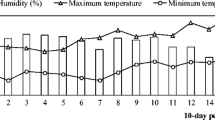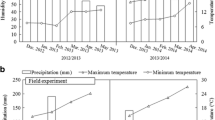Abstract
The effects of feeding by the planthopper Prokelisia dolus on its hostSpartina alterniflorawere examined under conditions of both high and low plant-nitrogen subsidy. Phloem feeding by P. dolus reduced the concentrations of γ-aminobutyric acid, isoleucine, leucine, lysine, threonine, and valine in S. alterniflora leaves. In contrast, glutamic acid was the only amino acid that increased in plants fed upon by planthoppers, and this increase was only observed in plants in the high N-fertilizer treatment. Planthopper feeding reduced the total concentration of amino/imino acids tested, and the concentration of essential amino acids, although this difference was not quite statistically significant. Generally, concentrations of individual amino acids in Spartina were higher in the high N-fertilizer treatment. Planthopper feeding and nitrogen fertilization also significantly impacted Spartina growth and production. Culm elongation, new leaf production, and tiller elongation were reduced and leaf mortality was increased on plants fed upon by planthoppers. Furthermore, planthoppers showed enhanced survival on the high-N plants. Nitrogen fertilization also moderated the effects of sap feeding on plant growth because the reduction of culm elongation associated with planthopper feeding was more pronounced in the low N-fertilizer treatment. Thus, feeding by P. dolus adversely affected both the nutritional quality and growth of Spartinaeffects that were tempered, in part, in plants receiving high nitrogen subsidy. Our results are discussed in the context of feeding-induced changes in plant quality and quantity as possible mechanisms mediating competitive interactions in Prokelisia planthoppers.
Similar content being viewed by others
REFERENCES
BACHELLERJ. D., and ROMEOJ. T. 1992. Biotic and abiotic stress effects on nitrogen chemistry in the salt marsh cordgrass Spartina alterniflora (Poaceae). Chemoecology 3:74–80.
BERUBED. E. 1980. Interspecific competition between Urophora affinis and U. quadrifasciata (Diptera: Tephritidae) for ovipositional sites on diffuse knapweed (Centaurea diffusa: Compositae). Z. Angew. Entomol. 90:299–306.
BLEECKERA. B., and ROMEOJ. T. 1982. Automated fluorometric amino acid analysis: The determination of nonprotein cyclic imino acids. Anal. Biochem. 121:295–300.
BRODBECKB., and STRONGD. 1987. Amino acid nutrition of herbivorous insects and stress to host plants, pp. 347–364in P. Barbosa and J. C. Schultz (eds.). Insect Outbreaks. Academic Press, San Diego.
CAGAMPANGG. B.PATHAKM. D., and JULIANOB. O. 1974. Metabolic changes in the rice plant during infestation by the brown planthopperNilaparvata lugens Stål (Hemiptera: Delphacidae). Appl. Entomol. Zool. 9:174–184.
CAMPBELLB. C. 1989. On the role of microbial symbiotes in herbivorous insects, pp. 1–44in E. Bernays (ed.). Insect-Plant Interactions, Volume 1. CRC Press, Boca Raton, Florida.
CAVALIERIA. J., and HUANGA. H. C. 1981. Accumulation of proline and glycinebetaine in Spartina alterniflora Loisel. in response to NaCl and nitrogen in the marsh. Oecologia 49:224–228.
CHENGC. H. 1971. Effect of nitrogen application on the susceptibility in rice to brown planthopper attack. J. Taiwan Agric. Res. 20:21–30.
COCKFIELDS. D.POTTERD. A., and HOUTZR. A. 1987. Chlorosis and reduced photosynthetic CO2 assimilation of Euonymus fortunei infested with euonymus scale (Homoptera: Diaspididae). Environ. Entomol. 16:1314–1318.
COOKA. G., and DENNOR. F. 1994. Planthopper/plant interactions: Feeding behavior, plant nutrition, plant defense, and host plant specialization, pp. 114–139in R. F. Denno and T. J. Perfect (eds.). Planthoppers: Their Ecology and Management. Chapman and Hall, New York.
CRAWLEYM. J. 1983. Herbivory. University of California Press, Berkeley.
DADDR. A., and KRIEGERD. L. 1968. Dietary amino acid requirements of the aphid Myzus persicae. J. Insect. Physiol. 14:741–764.
DAMMANH. 1993. Patterns of herbivore interaction among herbivores species, pp. 132–169in N. E. Stamp and T. M. Casey (eds.). Caterpillars: Ecological and Evolutionary Constraints on Foraging. Chapman and Hall, New York.
DENNOR. F., and PETERSONM. A. 1995. Density-dependent dispersal and its consequences for population dynamics, pp. 113–130in N. Cappuccino and P. W. Price (eds.). Population Dynamics: New Approaches and Synthesis. Academic Press, New York.
DENNOR. F., and RODERICKG. K. 1990. Population biology of planthoppers. Annu. Rev. Entomol. 35:489–520.
DENNOR. F., and RODERICKG. K. 1992. Density-related dispersal in planthoppers: Effects of interspecific crowding. Ecology 73:1323–1334.
DENNOR. F.DOUGLASSL. W., and JACOBSD. 1985. Crowding and host plant nutrition: Environmental determinants of wing-form in Prokelisia marginata. Ecology 66:1588–1596.
DENNOR. F.DOUGLASSL. W., and JACOBSD. 1986. Effects of crowding and host plant nutrition on a wing-dimorphic planthopper. Ecology 67:116–123.
DENNOR. F.MC CLUREM. S., and OTTJ. R. 1995. Interspecific interactions in phytophagous insects: Competition reexamined and resurrected. Annu. Rev. Entomol. 40:297–331.
DIXONA. F. G. 1971. The effect of aphids on wood formation. I. The effect of the sycamore aphidDrepanosiphum platanoides (Schr.)(Aphididae), on the growth of sycamoreAcer pseudoplatanus (L.). J. Appl. Ecol. 8:165–179.
DIXONA. F. G., 1985. Aphid Ecology. Blackie and Sons, London.
DIXONA. F. G., and LOGANM. 1972. Population density and spacing in the sycamore aphidDrepanosiphum platanoides (Schr.), and its relevance to the regulation of population growth. J. Anim. Ecol. 41:751–759.
DIXONA. F. G., and LOGANM. 1973. Leaf size and availability of space to the sycamore aphidDrepanosiphum platanoides. Oikos 24:58–63.
DIXONA. F. G.WELLINGSP. W.CARTERC., and NICHOLSJ. F. A. 1993. The role of food quality and competition in shaping the seasonal cycle in the reproductive activity of the sycamore aphid. Oecologia 95:89–92.
DOUGLASA. E. 1993. The nutritional quality of phloem sap utilized by natural aphid populations. Ecol. Entomol. 18:31–38.
EMDENH. F.VAN. 1973. Aphid host plant relationships, some recent studies. Entomol. Soc. N. Z. Bull. 2:54–64.
FAETHS. H. 1992. Interspecific and intraspecific interactions via plant responses to folivory: An experimental field test. Ecology 73:1802–1813.
FITTERA. H., and HAYR. K. M. 1981. Environmental Physiology of Plants. Academic Press, New York.
FRITZR. S.SACCHIC. F., and PRICEP. W. 1986. Competition versus host plant phenotype in species composition: Willow sawflies. Ecology 67:1608–1618.
HAUKIOJAE., and NIEMELÄP. 1979. Birch leaves as a resource for herbivores: Seasonal occurrence of increased resistance in foliage after mechanical damage of adjacent leaves. Oecologia 39:151–159.
HOUCKE. J., and GRIFFITHSG. W. 1980. Intracellular symbiotes of the Homoptera. Annu. Rev. Entomol. 25:161–187.
INBARM.ESHELA., and WOOLD. 1995. Interspecific competition among phloem-feeding insects mediated by induced host-plant sinks. Ecology 76:1506–1515.
KARBANR., and MYERSJ. H. 1989. Induced plant responses to herbivory. Annu. Rev. Ecol. Syst. 20:331–348.
KENMOREP. E. 1980. Ecology and outbreaks of a tropical insect pest of the green revolution, the rice brown planthopperNilaparvata lugens (Stål). PhD dissertation. University of California, Berkeley.
KOYAMAK. 1992. Essential amino acids for nymphal growth of the white-backed planthopper Sogatella furcifera (Horvath) (Hemiptera: Delphacidae). Jpn. J. Appl. Entomol. Zool. 36:177–181.
LAMBR. J., and MAC KAYP. A. 1987. Acyrthosiphon kondoi influences alata production by the pea aphidA. pisum. Entomol. Exp. Appl. 45:195–198.
LECKSTEINP. M., and LLEWELLYNM. 1973. Effect of dietary amino acids on the size and alary polymorphism of Aphis fabae. J. Insect Physiol. 19:973–980.
LIGHTFOOTD. C., and WHITFORDW. G. 1987. Variation in insect densities on desert creosotebush: Is nitrogen a factor? Ecology 68:547–557.
MATTSONW. J. 1980. Herbivory in relation to plant nitrogen content. Annu. Rev. Ecol. Syst. 11:119–161.
MC CLUREM. S. 1980. Foliar nitrogen: A basis for host suitability for elongate hemlock scaleFiorinia externa (Homoptera: Diaspididae). Ecology 61:72–79.
MC NEILLS., and SOUTHWOODT. R. E. 1978. The role of nitrogen in the development of insect/plant relationships, pp. 77–98in J. B. Harborne and H. F. van Emden (eds.). Biochemical Aspects of Insect/Plant Interactions. Academic Press, New York.
MEYERG. A. 1993. A comparison of the impacts of leaf-and sap-feeding insects on growth and allocation of goldenrod. Ecology 74:1101–1116.
MEYERG. A., and ROOTR. B. 1993. Effects of herbivorous insects and soil fertility on reproduction of goldenrod. Ecology 74:1117–1128.
MILLIKENG. A., and JOHNSOND. E. 1984. Analysis of Messy Data. Volume I: Designed Experiments. Van Nostrand Reinhold, New York.
MORANN. A., and WHITHAMT. G. 1990. Interspecific competition between root-feeding and leaf-galling aphids mediated by host-plant resistance. Ecology 71:1050–1058.
NIEMELÄP., and TOUMIJ. 1987. Does leaf morphology of some plants mimic caterpillar damage? Oikos 50:256–257.
PARRYW. H. 1977. The effects of nutrition and density on the production of alate Elatobium abietinum on Sitka spruce. Oecologia 30:367–375.
PFEIFFERD. G., and BURTSE. C. 1984. Effect of tree fertilization on protein and free amino acid content and feeding rate of pear psylla (Homoptera: Psyllidae). Environ. Entomol. 13:1487–1490.
PRESTIDGER. A. 1982. The influence of nitrogenous fertilizer on the grassland Auchenorrhyncha Homoptera. J. Appl. Ecol. 19:735–750.
PRESTIDGER. A., and MC NEILLS. 1982. The role of nitrogen in the ecology of grassland Auchenorrhyncha (Homoptera). Symp. Brit. Ecol. Soc. 22:257–281.
PRICEP. W.BOUTONC. E.GROSSP.MC PHERONB. A.THOMPSONJ. N., and WEISA. E. 1980. Interactions among three trophic levels: Influence of plants on interactions between herbivores and natural enemies. Annu. Rev. Ecol. Syst. 11:41–65.
RAVENJ. A. 1983. Phytophages of xylem and phloem: A comparison of animal and plant sapfeeders. Adv. Ecol. Res. 13:135–234.
RHOADESD. F. 1983. Herbivore population dynamics and plant chemistry, pp. 155–220, R. F. Denno and M. S. McClure (eds.). Variable Plants and Herbivores in Natural and Managed Systems. Academic Press, New York.
SANDSTRÖMJ. and PETTERSSONJ. 1994. Amino acid composition of phloem sap and the relation to intraspecific variation in pea aphid (Acyrthosiphon pisum) performance. J. Insect Physiol. 40:947–955.
SCHAFFERB., and MASONL. J. 1990. Effects of scale insect herbivory and shading on net gas exchange and growth of a subtropical tree species (Guaiacum sanctum L.). Oecologia 84:468–473.
SCHULTZJ. C. 1988. Plant responses induced by herbivores. Trends Ecol. Evol. 3:45–49.
SINGHT. N.ASPINALLD.PALEGL. G., and BOGGESSS. F. 1973. Stress metabolism. I. Nitrogen metabolism and growth in the barley plant during water stress. Aust. J. Biol. Sci. 26:45–56.
SŌGAWAK. 1971. Feeding behaviour of the brown leafhopper and varietal resistance of rice to this insect. Proc. Symp. Trop. Agric. Res. Tokyo 5:195–200.
SŌGAWAK. 1982. The rice brown planthopper: Feeding physiology and host plant interactions. Annu. Rev. Entomol. 27:49–73.
SRIVASTAVAP. N.AUCLAIRJ. L., and SRIVASTAVAU. 1983. Effect of nonessential amino acids on phagostimulation and maintenance of the pea aphidAcyrthosiphon pisum. Can. J. Zool. 61:2224–2229.
STEWARTG. R., and LARHERF. 1980. Accumulation of amino acids and related compounds in relation to environmental stress, pp. 609–635in B. J. Miflin (ed.). The Biochemistry of Plants, Volume 5. Amino Acids and Derivatives. Academic Press, New York.
TALLAMYD. W. 1985. Squash beetle feeding behavior: An adaptation against induced cucurbit defenses. Ecology 66:1574–1579.
TALLAMYD. W., and RAUPPM. J. 1991. Phytochemical Induction by Herbivores. John Wiley & Sons, New York.
TOUMIJ.NIEMELÄP.HAUKIOJAE.SIRÉNS., and NEUVONENS. 1984. Nutrient stress: An explanation for plant anti-herbivore responses to defoliation. Oecologia 61:208–210.
VETL. E. M., and DICKEM. 1992. Ecology of infochemical use by natural enemies in a tritrophic context. Annu. Rev. Entomol. 37:141–172.
WARINGG. L., and COBBN. S. 1989. The impact of plant stress on herbivore population dynamics, pp. 167–226in E. Bernays (ed.). Insect-Plant Interactions, Volume 4. CRC Press, Boca Raton, Florida.
WEIBULLJ. H. W. 1988. Free amino acids in the phloem sap from oats and barley resistant to Rhopalosiphum padi. Phytochemistry 27:2069–2072.
WELLINGSP. W., and DIXONA. F. G. 1987. Sycamore aphid numbers and population density. III. The role of aphid-induced changes in plant quality. J. Anim. Ecol. 56:161–170.
Author information
Authors and Affiliations
Rights and permissions
About this article
Cite this article
Olmstead, K.L., Denno, R.F., Morton, T.C. et al. Influence of Prokelisia Planthoppers on Amino Acid Composition and Growth of Spartina alterniflora . J Chem Ecol 23, 303–321 (1997). https://doi.org/10.1023/B:JOEC.0000006361.59085.22
Issue Date:
DOI: https://doi.org/10.1023/B:JOEC.0000006361.59085.22




